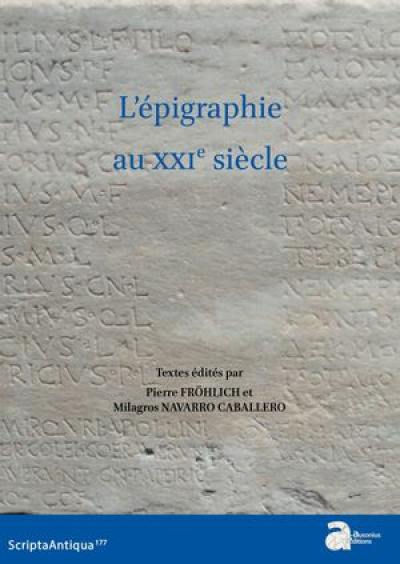
Collection(s) : Scripta antiqua
Paru le 07/02/2024 | Broché 438 pages
Professionnels
textes édités par Pierre Fröhlich et Milagros Navarro Caballero
Les textes inscrits sur un support durable (pierre, métaux, céramique), étudiés par l'épigraphie, constituent, avec la papyrologie, la source écrite directe pour étudier l'Antiquité classique. Ces textes inscrits, fondamentaux pour la recherche historique et philologique, sont en constant renouvellement grâce aux découvertes des fouilles archéologiques, mais aussi au travaux des épigraphistes, qui procurent régulièrement de nouvelles lectures et de nouveaux commentaires. L'épigraphie connait également un très important renouveau sur le plan méthodologique par l'apport des humanités numériques. En effet, elles ont changé non seulement la manière de publier les textes épigraphiques mais aussi la façon de faire l'acquisition des données. Ces transformations ont même des incidences éthiques sur la façon dont s'écrit actuellement l'histoire de l'Antiquité. Cette évolution est l'objet du présent ouvrage. Il présente le résultat de réflexions élaborées pendant cinq ans et exposées lors du XVIe congrès international d'épigraphique grecque et latine, tenu à Bordeaux en 2022, sous la direction d'épigraphistes de l'Institut Ausonius, en association avec l'Association internationale d'épigraphie grecque et latine (AIEGL).
Pour exposer le renouveau de l'épigraphie, pour faire le point sur l'avancement de nos connaissances, sur les questions méthodologiques, techniques ou éthiques que rencontre l'épigraphie contemporaine, l'ouvrage s'organise autour de bilans synthétiques, pour l'essentiel issu des conférences plénières du congrès. Ils sont distribués en trois parties. La première concerne les synthèses méthodologiques et s'intitule Étudier, éditer, publier les inscriptions au XXIe siècle. Ici, une attention particulière est portée au renouvellement de l'épigraphie grâce au développement des humanités numériques. La deuxième partie, intitulée L'épigraphie grecque et latine : nouvelles méthodes, nouveaux objets, nouvelles synthèses réunit les bilans thématiques. La troisième est celle de bilans géographiques : L'état de la recherche : bilans régionaux.
Texts inscribed on durable media (stone, metal, ceramics), analyzed through epigraphy, provide, along with papyrology, a direct written source for studying Classical Antiquity. These inscribed texts, which are fundamental to historical and philological research, are constantly being updated thanks not just to discoveries made during archaeological excavations, but also to the research of epigraphists, who regularly supply new readings and new commentaries. Epigraphy is also undergoing a major methodological revival thanks to the contribution of digital humanities. They have changed not only the way in which epigraphic texts are published, but also the way in which data are acquired. These transformations even have ethical implications for the way in which the history of Antiquity is currently written.
These developments form the subject-matter of this volume. It presents the results of five years of reflection, which were presented at the XVIth International Congress of Greek and Latin Epigraphy, held in Bordeaux in 2022, under the direction of epigraphists from the Institut Ausonius, in association with the International Association of Greek and Latin Epigraphy (AIEGL). To demonstrate the revival of epigraphy, to take stock of the advances made in our knowledge, and to examine the methodological, technical and ethical issues facing contemporary epigraphy, this book is organized around a series of syntheses, most of which derive from the plenary lectures given at the congress. These are divided into three sections. The first comprises a series of methodological syntheses and is entitled « Etudier, éditer, publier les inscriptions au XXIe siècle » (« Studying, editing and publishing inscriptions in the 21st century »). Here, particular attention is paid to the renewal of epigraphy thanks to the development of digital humanities. The second section, entitled « L'épigraphie grecque et latine : nouvelles méthodes, nouveaux objets, nouvelles syntheses » (« Greek and Latin epigraphy : new methods, new objects, new syntheses ») brings together a series of thematic reflections. The third section is devoted to geographical reports : « L'état de la recherche : bilans régionaux » (« The state of research : regional reports »).